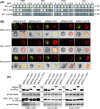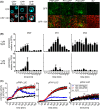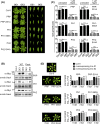A novel family of proline/serine-rich proteins, which are phospho-targets of stress-related mitogen-activated protein kinases, differentially regulates growth and pathogen defense in Arabidopsis thaliana
- PMID: 28755319
- PMCID: PMC5594048
- DOI: 10.1007/s11103-017-0641-5
A novel family of proline/serine-rich proteins, which are phospho-targets of stress-related mitogen-activated protein kinases, differentially regulates growth and pathogen defense in Arabidopsis thaliana
Abstract
The molecular actions of mitogen-activated protein kinases (MAPKs) are ultimately accomplished by the substrate proteins where phosphorylation affects their molecular properties and function(s), but knowledge regarding plant MAPK substrates is currently still fragmentary. Here, we uncovered a previously uncharacterized protein family consisting of three proline/serine-rich proteins (PRPs) that are substrates of stress-related MAPKs. We demonstrated the importance of a MAPK docking domain necessary for protein-protein interaction with MAPKs and consequently also for phosphorylation. The main phosphorylated site was mapped to a residue conserved between all three proteins, which when mutated to a non-phosphorylatable form, differentially affected their protein stability. Together with their distinct gene expression patterns, this differential accumulation of the three proteins upon phosphorylation probably contributes to their distinct function(s). Transgenic over-expression of PRP, the founding member, led to plants with enhanced resistance to Pseudomonas syringae pv. tomato DC3000. Older plants of the over-expressing lines have curly leaves and were generally smaller in stature. This growth phenotype was lost in plants expressing the phosphosite variant, suggesting a phosphorylation-dependent effect. Thus, this novel family of PRPs may be involved in MAPK regulation of plant development and / or pathogen resistance responses. As datamining associates PRP expression profiles with hypoxia or oxidative stress and PRP-overexpressing plants have elevated levels of reactive oxygen species, PRP may connect MAPK and oxidative stress signaling.
Keywords: MAPK; Oxidative stress; PAMPs; Pathogen resistance; Phosphorylation; Plant development.
Figures









Similar articles
-
The Arabidopsis transcription factor BRASSINOSTEROID INSENSITIVE1-ETHYL METHANESULFONATE-SUPPRESSOR1 is a direct substrate of MITOGEN-ACTIVATED PROTEIN KINASE6 and regulates immunity.Plant Physiol. 2015 Mar;167(3):1076-86. doi: 10.1104/pp.114.250985. Epub 2015 Jan 21. Plant Physiol. 2015. PMID: 25609555 Free PMC article.
-
An Overdose of the Arabidopsis Coreceptor BRASSINOSTEROID INSENSITIVE1-ASSOCIATED RECEPTOR KINASE1 or Its Ectodomain Causes Autoimmunity in a SUPPRESSOR OF BIR1-1-Dependent Manner.Plant Physiol. 2015 Jul;168(3):1106-21. doi: 10.1104/pp.15.00537. Epub 2015 May 5. Plant Physiol. 2015. PMID: 25944825 Free PMC article.
-
CRK2 and C-terminal Phosphorylation of NADPH Oxidase RBOHD Regulate Reactive Oxygen Species Production in Arabidopsis.Plant Cell. 2020 Apr;32(4):1063-1080. doi: 10.1105/tpc.19.00525. Epub 2020 Feb 7. Plant Cell. 2020. PMID: 32034035 Free PMC article.
-
GhMPK7, a novel multiple stress-responsive cotton group C MAPK gene, has a role in broad spectrum disease resistance and plant development.Plant Mol Biol. 2010 Sep;74(1-2):1-17. doi: 10.1007/s11103-010-9661-0. Epub 2010 Jul 3. Plant Mol Biol. 2010. PMID: 20602149 Review.
-
MAPK cascades in plant disease resistance signaling.Annu Rev Phytopathol. 2013;51:245-66. doi: 10.1146/annurev-phyto-082712-102314. Epub 2013 May 6. Annu Rev Phytopathol. 2013. PMID: 23663002 Review.
Cited by
-
Screening of microRNAs and target genes involved in Sclerotinia sclerotiorum (Lib.) infection in Brassica napus L.BMC Plant Biol. 2023 Oct 9;23(1):479. doi: 10.1186/s12870-023-04501-7. BMC Plant Biol. 2023. PMID: 37807039 Free PMC article.
-
Two genes encoding GH10 xylanases are essential for the virulence of the oomycete plant pathogen Phytophthora parasitica.Curr Genet. 2018 Aug;64(4):931-943. doi: 10.1007/s00294-018-0814-z. Epub 2018 Feb 22. Curr Genet. 2018. PMID: 29470644
-
Integrated metabolome and transcriptome analysis reveals salicylic acid and flavonoid pathways' key roles in cabbage's defense responses to Xanthomonas campestris pv. campestris.Front Plant Sci. 2022 Oct 31;13:1005764. doi: 10.3389/fpls.2022.1005764. eCollection 2022. Front Plant Sci. 2022. PMID: 36388482 Free PMC article.
-
Cell specialization and coordination in Arabidopsis leaves upon pathogenic attack revealed by scRNA-seq.Plant Commun. 2023 Sep 11;4(5):100676. doi: 10.1016/j.xplc.2023.100676. Epub 2023 Aug 28. Plant Commun. 2023. PMID: 37644724 Free PMC article.
-
The Tomato Mitogen-Activated Protein Kinase SlMPK1 Is as a Negative Regulator of the High-Temperature Stress Response.Plant Physiol. 2018 Jun;177(2):633-651. doi: 10.1104/pp.18.00067. Epub 2018 Apr 20. Plant Physiol. 2018. PMID: 29678861 Free PMC article.
References
MeSH terms
Substances
LinkOut - more resources
Full Text Sources
Other Literature Sources
Molecular Biology Databases
Research Materials

